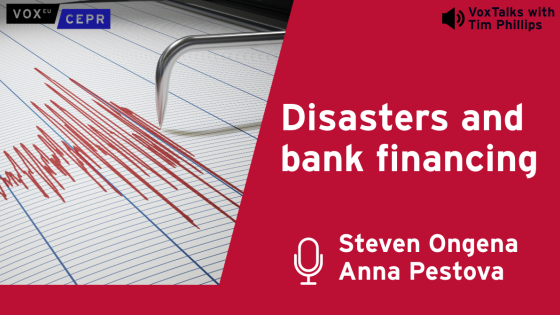During the financial crisis of the late 2000s, a large number of banks around the world either failed, or received financial aid from national authorities, thereby inflicting substantial losses on the entire system. From an economic viewpoint, the recapitalisation of the troubled banking institutions – coupled with the costs of the failures and of the large stimulus programmes which national governments launched to revive demand – led to the explosion of public debt in many advanced economies. These sorts of fiscal problems are to a large extent responsible for the observed upsurge in sovereign risk, which has put further upward pressure on countries’ borrowing costs and undermines (in some cases) the value of their currencies. Within this context, several indebted countries still face considerable difficulties in repaying their loans or obtaining new loans, as they have been locked out markets. In contrast, a well-functioning and robust banking sector largely contributes to the stability of the entire financial system and is a crucial determinant of economic growth (see, e.g., Koetter and Wedow 2010). That said, the policy challenge for authorities constructing the new regulatory and supervisory framework for banks, widely known as Basel III, is to take all necessary measures to strengthen the stability of the banking sector by seriously considering the root causes of the global financial crisis.
Off-balance-sheet bank leverage
One of the root causes for the bank sector’s accumulation of severe structural weaknesses and adverse market dynamics during the pre-crisis period was the high degree of bank leverage. Traditionally, leverage arises directly through the use of deposited funds or any other balance sheet items – for instance, bonds and credit lines – as a supplementary tool of banks’ equity capital to finance fresh loans and investments. However, leverage can also be traced off banks’ balance sheets. As we show in a recent paper, banks were able to transfer part of their leverage (and the accompanying risk) off their balance sheets in the years running up to the crisis, through their engagement in securitisation and Over-The-Counter derivatives activity (Papanikolaou and Wolff 2014). Both of those undertakings were directly linked to what became known as ‘regulatory arbitrage’, which was the response of banks to the restrictions imposed on their operations by Basel I and II. Shortly after the crisis erupted, banks sought to deleverage their positions by selling a large part of their on- and off-balance-sheet assets and by reducing their debt with the goal of returning to a safe level of capital.
The empirical analysis in Papanikolaou and Wolff (2014) relies on a dataset that consists of 20 US Banking Holding Companies (BHCs) as reported in Table 1. The sample institutions are selected on the basis of their systemic importance for the US economy and the degree of their off-balance sheet exposure as documented in the ‘Bank Derivatives Reports’ of the Office of the Comptroller of the Currency.
Table 1. Sample of banks

Figures 1 and 2 that follow rely on consolidated balance sheet and income statement data for the set of 20 sample banks and show the trajectory of the average of derivatives leverage (DERLEV) and that of securitisation activity (SECLEV) over the period 2002q1-2012q3.
Figure 1. Average of derivatives leverage for sample banks, 2002-2012

Figure 2. Average of securitisation activity for sample banks, 2002-2012

As we can see, both off-balance sheet leverage variables follow an increasing trend during the pre-crisis period (i.e., from 2002q1 to 2007q2). By contrast, a sharp downward trend is reported in the crisis period which runs from 2007q3 through 2012q3. Apparently, the large US BHCs accumulated a high degree of leverage off their balance sheets during the economic upturn, whereas they significantly reduced their off-balance sheet holdings after the eruption of the crisis (see Cornett et al 2011).
Individual bank risk and systemic risk
It is important to examine the course of the overall risk-taking behaviour of banks and that of systemic risk. To this end, we calculate the former as the quarterly standard deviation of each sample bank’s daily stock market returns (TOTRISK); the latter, systemic risk, is captured by applying the Acharya et al (2012) Marginal Expected Shortfall (MES), which describes how the total risk exposure of an individual bank adds to the banking system’s overall risk level.
Figure 3. Average risk-taking behaviour of sample banks

Figure 4. Average MES of sample banks

Figure 3 shows that the average TOTRISK across the 20 banks. Note that it follows an increasing trend before the crisis hits; the trend reverses after the onset of the crisis. Figure 4, on the other hand, reveals that the average MES continues growing throughout the examined period.
Off-balance sheet leverage, individual bank risk, and systemic risk: A synthesis
Based on the results of our regression analysis, the increase in the off-balance sheet leverage activities of banks led to higher MES and also higher TOTRISK prior to the outbreak of the crisis. This can be explained as follows. Over the past decade or so, banks responded to the augmented demand for credit instruments with higher yield by developing financial engineering techniques and creating modern types of products such as credit derivatives, credit default swaps, collateralised debt obligations, and securitised loans, to name a few. Although these developments may have come about as a result of the wider financial advances aimed at improving the efficiency of the system, they also provided opportunities to increase banks’ off-balance sheet leverage, and to shift risks amongst market participants in highly complicated ways. Most of the then-new financial instruments were indeed opaque and masked the extent of leverage and interconnectedness of risk, which appeared to be spilled-over across a wide range of banks and markets worldwide. As a consequence, the involvement of banks in off-balance sheet leverage business during the pre-crisis period increased both individual bank risk and systemic risk.
The deleveraging process, which mainly occurred off the balance sheets of banks, was found to have worsened the systemic risk profile of the US banking system, though it increased the soundness of individual banks. Our explanation is the following – when a significant number of banks attempt to deleverage their positions with the aim of strengthening their leverage ratios, various destabilising factors can be set in motion. In the recent crisis, several systemic financial institutions sold part of their assets at the same time – the market prices of those assets fell almost immediately, augmented by the fact that the selling assets were of the same class (e.g., mortgage loans, housing assets, etc.). Asset prices dropped to the point where sale proceeds could not retire enough debt to improve leverage ratios; in fact, ratios actually deteriorated. Banks then sought to hold off selling for as long as possible and, as a result, the market froze up. As a consequence, a large volume of hard-to-value assets carried by highly leveraged institutions was looming over the markets during the crisis period. Overall, we argue that any serious fall in asset prices, or any large losses in loans or securities, or any cut in cash flows can exert reverse-leverage effects on the system, and especially in a system that consists of highly leveraged institutions. Arguably, the deleveraging process puts additional downward pressure on the entire system, even though it is found to be beneficial for the soundness of banks on an individual basis.
Concluding remarks and policy implications
We find support for the view that, before the onset of the crisis, banks accumulated leverage both on and, especially, off their balance sheets. Indeed, banks were able to expand leverage in ways that were previously impossible – by largely relying on new financial products, they managed to extend the short-term funding of their medium- and long-term assets. This increased maturity mismatch and raised the probability of bank runs. This in turn raised the levels of individual bank risk and systemic risk, thus forcing the system to either fail or consider large-scale bailouts. An additional threat to systemic stability was formed after the onset of the crisis, when banks started to dispose of the large number of ‘bad assets’ they used to hold, either on or off their balance sheets. Although this deleveraging process harmed the stability of the system, it has been beneficial for the soundness of individual banks.
We postulate that the expansion of derivatives trading associated with the increased securitisation activity was disregarded by regulatory and supervisory authorities in the years running up to the crisis. The direct link between off-balance sheet leverage and systemic risk provides the necessary condition for the current debate on stricter bank regulations – the imposition of an explicit off-balance-sheet leverage ratio, as has been the case in Canada for many years now (see Bordeleau et al 2009). A leverage ratio that does not consider off-balance-sheet items encourages banks to either further expand such activities, or to innovate other products that can also take place off their balance sheets. Put differently, the failure to incorporate off-balance sheet items in a measure of leverage exposure provides additional incentives for banking firms to shift these items off their balance sheets and circumvent the traditional on-balance sheet leverage restrictions. Thankfully, Basel III is moving towards this direction as it takes into account the off-balance sheet items which will be converted using a flat 100% credit conversion factor.
We should not neglect that the Basel I & II capital requirements were one of the chief reasons that drove banks to hide part of their assets – and hence, part of their risk – off their balance sheets. Regulatory arbitrage was the game that took place between banking firms and authorities, whereby the former were innovating and developing new financial instruments with the goal of evading the scrutiny of supervisors and increasing their returns. Authorities, meanwhile, were tightening the rules in order to avoid excessive risk-taking and to safeguard the stability of the financial system. Therefore, in our view, two different, complementary leverage ratios need to be imposed – one that targets on-balance-sheet items and one that restricts off-balance sheet leverage.
All things considered, our findings could play a role in the current discussion about a possible revival of the Glass-Steagall Act, which banned commercial banks from underwriting, holding, or dealing in corporate securities, thereby essentially separating investment from commercial banking activities.
References
Acharya, V V, L H Pedersen, T Philippon, & M P Richardson (2012) “Measuring systemic risk”, CEPR Discussion Paper, No. DP8824.
Bordeleau, E, A Crawford, and C Graham (2009) “Regulatory constraints on bank leverage: Issues and lessons from the Canadian experience”, Bank of Canada Discussion Paper Series No. 15.
Cornett, M M, J J McNutt, P E Strahan and H Tehranian (2011) “Liquidity risk management and credit supply in the financial crisis”, Journal of Financial Economics, 101: 297-312.
Koetter, M, M Wedow (2010) “Finance and growth in a bank-based economy: Is it quantity or quality that matters?” Journal of International Money and Finance, 29: 1529-1545.
Papanikolaou, N I and C P Wolff (2014) “The role of on- and off-balance-sheet leverage of banks in the late 2000s crisis”, Journal of Financial Stability, 14: 3-22.








